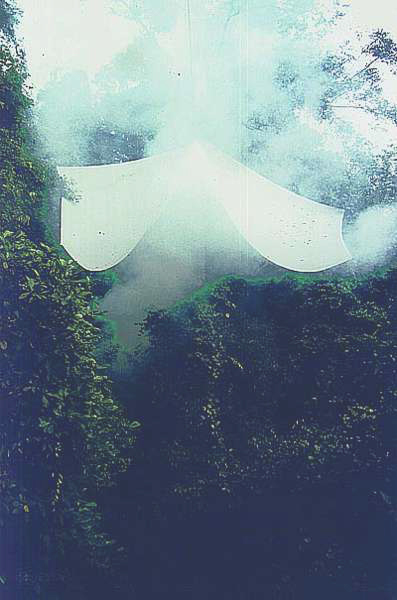
Insecticidal knock down fogging as a method to investigate arboreal ant communities in tropical lowland rain forests PDF)
by Andreas Floren, University of Wuerzburg
In 1991, we started to investigate the diversity, structure, and dynamics of arboreal arthropod communities in SE-Asian lowland rain forests. From the beginning arboreal Formicidae were in the focus of the analysis. As it turned out, ants can be collected by fogging very efficient. For the fogging we use only natural pyrethrum, diluted in a highly raffinated white oil, as an insecticide. This mixture is highly specific to arthropods, degrades photochemically within hours and does not persist in the trees (Floren and Linsenmair 1997). Fogging was applied mainly to small trees of the lower canopy stratum (mean height 24 meters, crown width 8 meters) which can be sampled almost completely in a tree specific way. Most of the study trees were Euphorbiaceae of the genus Aporusa (A. lagenocarpa and A. subcaudata). With all re-foggings after different periods of time, 79 foggings were carried out in the primary forest. In order to investigate how anthropogenic disturbance changes arboreal communities, another 89 foggings were carried out in secondary forests varying in age and in the degree of isolation from the primary forest. |
Fig. Canopy fogging is an appropriate methode to deal with the immense diversity of the tropical arthropod fauna. This picture shows the fogging of an Aphorusa tree by the team of Andreas Floren. The fog is prepared by the use of raffinated white oil as a carrier substance for the insecticide. The fog is applicated within the tree at a height of about 15 m. A roof above the tree prevents insects from the higher strata to contaminate the sample (the Dipterocarp forest reaches heights up to 60 m). (Picture from Floren 2005) |
Analysis showed that ants are the most abundant taxa in the trees but that they are of moderate diversity. Up to now 331 species have been identified from 153.504 collected ant individuals. Ants nest in the trees and form long lasting and distinguishable communities. In order to check efficiency of the fogging and to proof the quality of our data ant nests were mapped in the trees. This was achieved by placing tuna baits on all branches of a tree that attracted the ants. Following the ants made it then easy to find their nests. Nest mapping confirmed that ant species abundance-distribution is reflected pretty well in the fogging samples ( Floren and Linsenmair 2000). Therefore, fogging data give a realistic picture of ant community structure. Analysis showed that ant communities of the primary forest were not be distinguishable from randomly composed communities while they showed a predictable deterministic pattern in the disturbed forest ( Floren et al. 2001). Furthermore, ant abundance has declined significantly in the disturbed forests where only 10% of the number of species occurred that had been found in the primary forest (Floren and Linsenmair in press). This indicates that human disturbance can lead to high extinction patterns and change the composition of ant communities as well as the dynamics of the whole system.
see also new article from Andreas Floren in the Myrmecological News
Literature
Back to the Ecology overview




